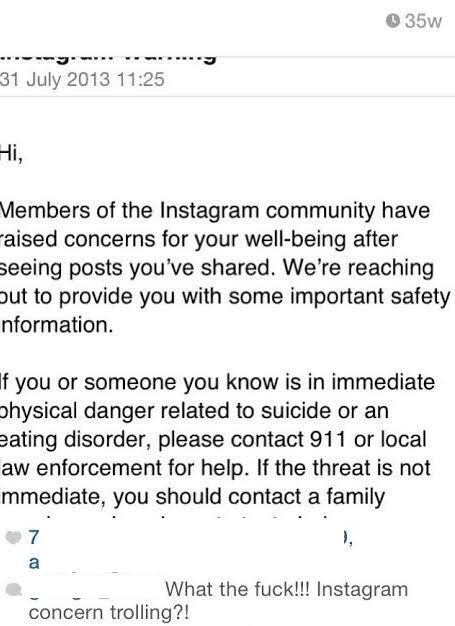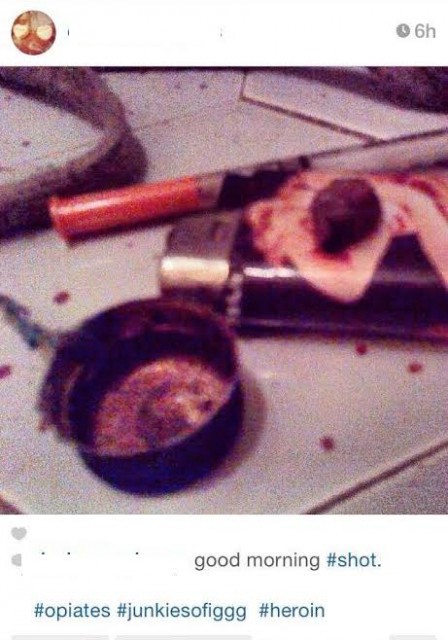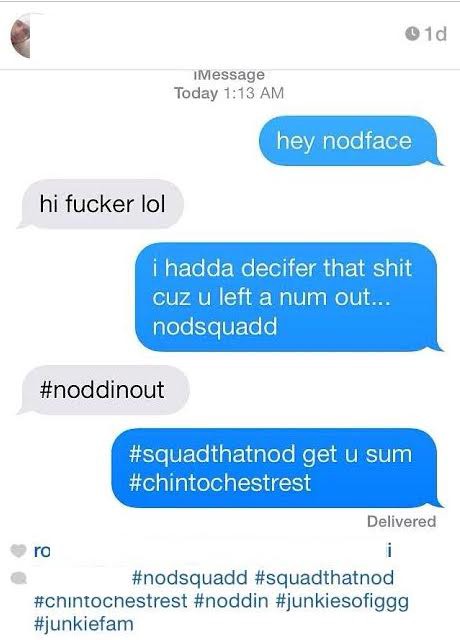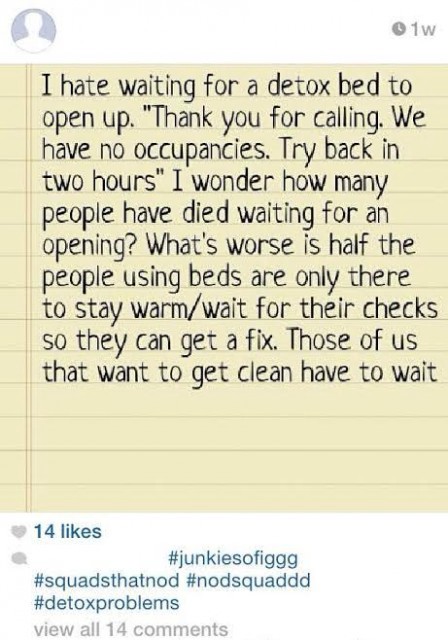Status Update, I’m Sober: Talking to Belle, Recovering Heroin Addict and “Junkie of Instagram”
by Melissa Batchelor Warnke

In this series, people in recovery speak about the ways in which they have used social media as a tool. This month’s interview is with “Belle,” a mid-twenties former college student working to get clean against an enduring pill and heroin addiction. Belle is a member of the group Vice dubbed “junkies of Instagram,” a collection of drug users who document their lives and habits on the photo-sharing site.
Belle is softspoken and polite; she asked if she could smoke during our interview, even though we were connected via Skype. What Vice and The Daily Mail missed, she said, is that drug users are using the site not to glorify their use, but to help save each other’s lives. This interview has been edited for length and clarity.
We were originally supposed to speak a few weeks ago, but you suffered a heroin relapse. How are you doing?
I’m feeling much better. I’m in a dry house in the UK right now.
I’m glad to hear that. What’s your story?
I started smoking weed when I was 13 and that escalated into club drugs. When I was 18, I used heroin a few times with a boyfriend. I pulled back because my A-levels [the UK equivalent of the SATs] were coming up. But that early experience set the scene in my mind; I thought I had had a spiritual revelation. Now I just think I nearly overdosed.
After high school, I moved from the UK to the US, where my boyfriend was from. We got into shooting up painkillers: oxy [oxycontin], roxy [roxicodone], dillies [hydromorphone], morphine. I was supporting myself, my habit, my new boyfriend and working full-time. On top of that, I was commuting into New York every day for college.
That’s a lot.
It was crazy. I probably only could do it because I was high all the time. After a bad breakup, I started wandering the streets, asking people where I could get diesel [heroin]. Someone stole my money and then someone took me up to an apartment building and got me a bundle [10 bags]. I used the whole fall of 2010 and developed a real habit; finally, my roommate and my ex called my mom in the UK. She made me come home to detox at her house.
I went back to college in the spring, but I was still devastated about the breakup. My roommate introduced me to benzos; she’d give me loads of Xanax just to get me out of bed. A drug dealer lived on the top floor of the warehouse we lived in, so it was really easy to get pills. In spring 2010, I went up to his apartment but he didn’t have anything. I started crying from withdrawal. Another guy was there and he said he had pills that would get me off dope — suboxone [a drug used to treat opiate addiction]. I took them and started dating him. Eventually, I stopped taking opiates and painkillers and I was sticking to my script, but I still had quite a bad benzo habit.
At that point, you’d been in the US for a year and you were using the whole time.
Right. That summer, I did study abroad. My ex came to visit me and I ended up getting pregnant. I only found out when we got back. I basically had a breakdown. I didn’t eat, I didn’t go to the doctor and I didn’t go back to school. He convinced me to go to Planned Parenthood when I was four months along — too far along. After the abortion, I went full tilt and started using heroin again. I couldn’t cope at all.
Eventually, he checked me into a psychiatric hospital. I didn’t have insurance, so to get me on the detox ward, he said that I tried to kill myself. From there, I went back to England for my first stint in rehab.
What was your experience in rehab?
I did a 28-day program and then went to an all-women’s treatment center, where I stayed for six months. I started going to NA meetings and really connected with the fellowship. But my downfall was that I refused to address the issue of my partner; I was still with the guy I had conceived with back in the States. He’s a commercial fisherman who made a lot of money selling weed and ecstasy. I left rehab a month early and went back to him. Things weren’t the same between us and his brother’s girlfriend got me back on heroin.
Then a woman I met in the hospital detoxed me at her house. I moved back into the city and started going to NA meetings. But before long, I hooked up with my old roommate and started using pills again and dancing again. So a week before Christmas, I called my parents and said “Do you mind if I come home? I fucked up.” [Belle started crying]
This is hard.
My parents got me a ticket back and I stayed with them until the spring of 2013, when I went back into rehab to get clean off of methadone and a benzo habit. I did six weeks at primary detox and went to the same secondary, moved into a dry house and then managed to get four months clean. As you know, I relapsed about a month ago.

I’m truly sorry. How did you relapse?
I started using for five days, and was getting sick when I tried to stop. I had built up all these friends in NA, but I thought I couldn’t tell anyone. I believed it would put my spot in the dry house at risk and that I would let everyone down. My ego and my pride and my shame made me keep it a secret.
How did you stop using?
A guy said he would help me detox, but he’d give me one subutex [another drug used to treat opiate addiction] every two days. Then he started asking for “favors” for them. Last Sunday, he got violent. So I had to tell my social worker, who brought me to a project that our dry house is associated with, and now I’m doing a quick detox on subutex, my sponsor is helping and they’re letting me stay in the sober house. A few people I’ve gone through rehab with are very disappointed, but that’s the consequence of what I’ve done. This is where I am now.
What is the dry house’s policy on relapse?
If you relapse, they set up a prevention plan and you have to attend abstinence workshops. The dry house is run by a non-profit homeless charity, so they’re more interested in getting people housed than kicking them out on the street. There are other ones in the uK where, if you use, you have two hours to get out.
I have friends who have been through that. I have actually never heard of a dry house that is supportive through relapse.
It’s very rare. I’m incredibly lucky and grateful to be where I am.
Heroin addiction is a major topic in the United States right now. People who have never used heroin are struggling to understand what draws users back to the drug. Have you come back when you’re in a place of emotional turmoil? Or do you feel it as a physical dependency, or are they interconnected?
In a sense, it’s all connected. Phillip Seymour Hoffman died during my relapse. A good friend of mine died of a heroin overdose the same week. Heroin is unlike any other drug. It’s kind of a big warm hug. You can be living in a gutter with everything going wrong in your life, but it makes you feel like everything is beautiful, nothing hurts you, everything is OK. Then you have to take more and more of it to get that initial feeling. It is a massive emotional crutch.
What forms of social media do you use?
Facebook and Instagram. I mainly use Facebook to connect with my friends who are clean and in recovery, friends I know in real life from going to meetings. I communicate with my sponsor using Facebook chat. Instagram is a little different. I started using it when I relapsed in the winter of 2012. I’ve found a community of addicts where some don’t want to get clean, others are trying, but we’re all connected.

What is the makeup of the Instagram addict community?
It skews very young — mostly people in their late teens and early twenties. It is about 80% female. Some post pictures of their drugs or people shooting up, while others post normal Instagram stuff like selfies and pictures of their pets. A lot of these people aren’t out as addicts in their regular life, so Instagram is where we connect.
It’s interesting that the community is so heavily female.
It absolutely is; the most popular three people who post explicit photos of drug use are females. I can’t really tell you why. Maybe because girls need more of an intimate connection with people who are going through the same things they are.
How do addicts on Instagram find each other?
There are two hashtags that people post under. One is junkiesofiggg with a couple gs, because they keep closing the hashtag down. The other is nodsquadd, which is slang for when people nod out on heroin. We go through a lot together. There are people on these hashtags who are ostensibly homeless and live in their cars, accessing Instagram from McDonald’s parking lots. I’ve sent people money so they can get a hotel room. That happens a lot.
Are there other ways in which addicts on Instagram help each other?
What’s very common is if someone is able to get a script for suboxone, they’ll send other addicts little bits of it if they don’t have money to use or are trying to get clean. It’s amazing. There’s one woman who is 20 years sober who sends out packets of clean needles and naloxone [a drug used to counter the effects of opioid overdose] — she’ll send those out to kids who don’t have access.
Have you met any of your Instagram community members in real life?
I haven’t because I’m in the UK right now, but others have met up. We all talk on Kik, which is like What’s App but anonymous. You don’t need to give your phone number, just a username. There really are two sides of the community. People who don’t want to give up using will post pictures of their drugs and everybody else will write like, “Oh, man — that looks great!” or “Wish I had that, have fun!” But when people are struggling and decide to detox, they’ll get 50 messages of support. It’s amazing. If someone says they want to detox, people who know the area they’re in will post details of detoxes that don’t require insurance. There’s even one addict relationship that has developed over Instagram. They’ve just been on vacation together in California.
How do you use the hashtags when you’re in recovery but your recovery feels fragile? Can looking at pictures of people using feel triggering, or are you able to put some distance between it?
Oh, absolutely they feel triggering! I go through phases where I delete a lot of accounts of using addicts and, when I feel I’m in a better place, I’ll re-add them. This last relapse I made another account where I posted a few pictures of my using, but I deleted it because it didn’t feel right. My personal Instagram has a lot of people in recovery following, as well as my sister, so I don’t feel comfortable posting graphic images.

I know that the Vice story rubbed you the wrong way and I’m really keen to contextualize the hashtag photographs. I want to understand the community that you’re talking about as you experience it, not as I experience it from the outside.
I feel that if they had gone into our community further and checked out our hashtags more, looked at what people are saying to each other, they would have seen that this isn’t a group of kids celebrating drug use. Our community is a place where people can anonymously post pictures of their using lives and just be. Not everybody wants to quit, but the people who post graphic pictures all have disclaimers at the top saying “I don’t condone drug use, this is my personal experience.” It’s a diary we use to understand each other.
The Vice story and the Daily Mail story missed all the support we give each other. When one of us gets clean, it’s not like we’re shunned from the community. Everyone is thrilled, we count days with each other, we celebrate birthdays. One of my closest friends on there was a heroin addict for 17 years and used to post very graphic photos of her using. She recently got her 90 days keyring, and she got over 100 comments of people in our community saying “Well done baby, we knew you could do it.”
How does that virtual support community relate to the NA community that you are a part in real life? Do you feel you communicate in different ways?
It’s very different mainly because NA is all about support for sobriety. I really don’t want to disparage NA in any way because it saved my life and given me my life back. NA isn’t at all judgmental, but it’s not a place you’ll go when you relapse and say “Oh I just had the greatest hit ever.” Instagram is a place where you can do that. Of course you can tell the full story at NA as well, but you only go when you say “I really want to stop.” With Instagram, to be a part of the community, you don’t have to want to stop.
Do you use Tumblr?
I do, but not in the same way. My Tumblr account is more like a straight drug diary.
What’s in your future?
I’ve applied to return to university this fall in the UK, with the aim of studying international development. Hopefully I’ll be off subutex in the next month. I’m doing 90 in 90, which is an NA term for 90 meetings in 90 days. I’m going to keep interacting with my buddies on Instagram because I’ve made some really good friends. A few weeks ago, I sent one of them a few subutex.
Subutex is legal in both the US and the UK, but it’s illegal to send it between countries, correct?
That’s right.
So why would you have to send it to someone in the US? Is it a lack of supply, access or health insurance?
Addicts who want subutex but can’t get it don’t have health insurance. Always.
How expensive is it?
In the US they have suboxone, which is a slightly different drug. My ex’s script was $800/month without insurance. In the UK, I get it for free, free drug counseling, everything like that.
This is a broader conversation, but it’s worth noting that you’re had such a different experience working through your recovery in the UK than you did working through it in the US.
It’s crazy different.
Melissa Batchelor Warnke is a freelance writer, researcher and editor. She currently studies microcommunities and badass women. Follow her on twitter at @thewarnke.
Previously: “Status Update, I’m Sober: Melanie”